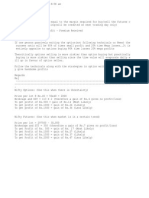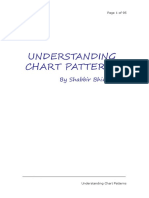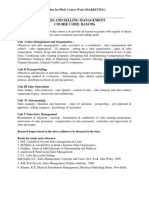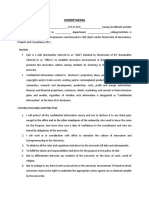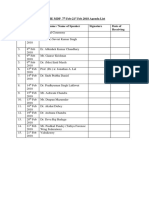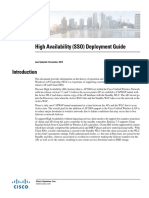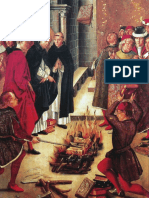Santali Alphabets
Santali Alphabets
Uploaded by
Abhi RicCopyright:
Available Formats
Santali Alphabets
Santali Alphabets
Uploaded by
Abhi RicOriginal Description:
Copyright
Available Formats
Share this document
Did you find this document useful?
Is this content inappropriate?
Copyright:
Available Formats
Santali Alphabets
Santali Alphabets
Uploaded by
Abhi RicCopyright:
Available Formats
Santali alphabet (Ol Cemet'/Ol Chiki)
Origin The Santali alphabet, which is also known as Ol Cemet', Ol Ciki or simply Ol, was created in the 1920s by Pandit Raghunath Murmu as part of his efforts to promote Santali culture. Every other major language in India had its own alphabet, so he thought Santali should as well. Until the invention of this alphabet, Santali was either not written at all, or was written with the Bengali or Oriya alphabets. Christian missionaries prefer to write Santali with theLatin alphabet. Used to write: Santali or Santhali, a Munda language spoken by about 5.8 million people in India, Bangladesh, Nepal and Bhutan. The alphabet was designed for a southern dialect of Santali spoken in the Mayurbhanj district of the Indian state of Orissa. Santali is also written with the Oriya, Bengali, Devanagari and Latin alphabets.
Sample text
Source: http://wesanthals.tripod.com/Disomk05/DK0361a.html Links
Information about the Ol Cemet' script (includes a free Ol Cemet' font) http://www.wesanthals.org Information about the Munda languages http://www.livingtongues.org/moremunda.html Related languages Ho, Mundari, Santali, Sora Alphabets Armenian, Avestan, Bassa (Vah), Beitha Kukju, Coptic, Cyrillic, Elbsan, Etruscan, Fraser,Georgian (Asomtavruli & Nuskha-khucuri), Georgian (Mkhedruli), Glagolitic, Gothic, Greek,Hungarian Runes, Irish, Korean, Latin, Lycian, Lydian, Manchu, Merotic, Mongolian, N'Ko,Ogham, Old Church Slavonic, Oirat Clear Script, Old Italic, Old Permic, Orkhon, Pollard Miao, Runic, Santali, Somali, Sutton SignWriting, Tai Lue, Thaana, Uyghur
You might also like
- Stock Phoenix - Tweezer TopDocument20 pagesStock Phoenix - Tweezer Toppagis31861No ratings yet
- Applied For The Post Of: PGT/TGT English Curriculum Vitae Roopali AroraDocument6 pagesApplied For The Post Of: PGT/TGT English Curriculum Vitae Roopali AroraRahul SaraswatNo ratings yet
- Grade 9 English FalDocument45 pagesGrade 9 English FalRoman TakishimaNo ratings yet
- Advanced Technical Analysis en PDFDocument23 pagesAdvanced Technical Analysis en PDFTarkeshwar MahatoNo ratings yet
- WB Haat ListDocument236 pagesWB Haat Listmprabhakaran1No ratings yet
- English Santhali PDFDocument8 pagesEnglish Santhali PDFSubhadeep Sinhamahapatra100% (1)
- Forward: Muhammad The Prophet of IslamDocument17 pagesForward: Muhammad The Prophet of IslamSajid QureshiNo ratings yet
- Price Action Strategy by Nitin Bhatia - RulesDocument2 pagesPrice Action Strategy by Nitin Bhatia - RulesSnehal PanchalNo ratings yet
- India VIXDocument2 pagesIndia VIXNihilisticDelusionNo ratings yet
- Contributions of Western Scholars To Kannada LinguisticsDocument20 pagesContributions of Western Scholars To Kannada LinguisticsMallikarjun100% (1)
- Calculation of AND Indexes: NSE BSEDocument5 pagesCalculation of AND Indexes: NSE BSEnaveenNo ratings yet
- Khalitya (Hair Fall) Management - Ayurvedic: PerspectiveDocument6 pagesKhalitya (Hair Fall) Management - Ayurvedic: Perspectivemehak cNo ratings yet
- Things To Remember Before Entering Stock MarketDocument93 pagesThings To Remember Before Entering Stock MarketBKNo ratings yet
- Option WritingDocument1 pageOption Writingavinash008jha6735No ratings yet
- CCI - Commodity Channel Index For Banknifty On 15 Min Heikineshi CandleDocument1 pageCCI - Commodity Channel Index For Banknifty On 15 Min Heikineshi Candlesripeksha123No ratings yet
- PAMAC Group India Fraud Bulletin - December 2k11Document19 pagesPAMAC Group India Fraud Bulletin - December 2k11dhruvdubey81No ratings yet
- Article RSI Indicator FilterDocument5 pagesArticle RSI Indicator Filtermuthu shunmugam arumughamNo ratings yet
- What Is Sensex - How Is It Calculated - Basics of Share Market PDFDocument14 pagesWhat Is Sensex - How Is It Calculated - Basics of Share Market PDFMayur Mohanji GuptaNo ratings yet
- Daily Profits India - Learn Stock Market Day Trading - Share Trading TechniquesDocument11 pagesDaily Profits India - Learn Stock Market Day Trading - Share Trading TechniquesjprakashusNo ratings yet
- Strategies Using ETFsDocument16 pagesStrategies Using ETFscmms88No ratings yet
- Technical Analysis: P.G.KulkarniDocument295 pagesTechnical Analysis: P.G.KulkarniSyed Tousief100% (1)
- Fibonacci Retracement - How To Use It While Trading StocksDocument2 pagesFibonacci Retracement - How To Use It While Trading StocksravikantssharmaNo ratings yet
- Technical AnalyyysisDocument95 pagesTechnical AnalyyysisSoumya Ranjan PandaNo ratings yet
- Fundamental Analysis and Technical Analysis of Financial DataDocument5 pagesFundamental Analysis and Technical Analysis of Financial DataAyesaNo ratings yet
- Bollinger Band and Keitner ChannelsDocument5 pagesBollinger Band and Keitner Channelspruthvirajhn72100% (1)
- JPSC Mains Exam Copy Format - 86a27ee5 Ad84 4902 b65f 8b30448f5c58Document33 pagesJPSC Mains Exam Copy Format - 86a27ee5 Ad84 4902 b65f 8b30448f5c58Amit MondalNo ratings yet
- Introduction To RENKODocument7 pagesIntroduction To RENKOKathiravan RNo ratings yet
- Option Chain Part1Document3 pagesOption Chain Part1ramyatan SinghNo ratings yet
- How Do I Master Intraday TradingDocument3 pagesHow Do I Master Intraday TradingAnonymous w6TIxI0G8lNo ratings yet
- Daytrade Master IndicatorDocument8 pagesDaytrade Master IndicatorMUDRICK ACCOUNTSNo ratings yet
- English Grammar - WinmeenDocument213 pagesEnglish Grammar - WinmeenHema RamNo ratings yet
- 3commoncandlemistakes PDFDocument17 pages3commoncandlemistakes PDFpaoloNo ratings yet
- Metaverse Ebook OFA+OIDocument17 pagesMetaverse Ebook OFA+OIalphahacker8920No ratings yet
- MTF Stochastic Trading: TRADING GUIDELINES FOR THE ORIGINAL TEMPLATE (Both Stochastics Are Set at 11,3,3Document2 pagesMTF Stochastic Trading: TRADING GUIDELINES FOR THE ORIGINAL TEMPLATE (Both Stochastics Are Set at 11,3,3Irvan HidanNo ratings yet
- Dr. Ravi R KumarDocument82 pagesDr. Ravi R Kumarlakshitsaini971996No ratings yet
- Indicaters of StocksDocument5 pagesIndicaters of StocksarshadalicaNo ratings yet
- One Good TradeDocument16 pagesOne Good Tradelucky_brijeshNo ratings yet
- Poa FyersDocument4 pagesPoa Fyerspradeep.jaganathanNo ratings yet
- EXZhuqf CXTDocument62 pagesEXZhuqf CXTKHUSHBOO HIRAWATNo ratings yet
- Neutral Strategy OptionsDocument4 pagesNeutral Strategy OptionsAsokaran PraveenNo ratings yet
- VIX As A PredictorInsightsDocument9 pagesVIX As A PredictorInsightsSandipNo ratings yet
- The Industry HandbookDocument34 pagesThe Industry HandbookslpypndaNo ratings yet
- Trading Plan Essentials: Capital: Risk: Risk/Reward: Profit Target: Processes: Management: Limits: WithdrawsDocument1 pageTrading Plan Essentials: Capital: Risk: Risk/Reward: Profit Target: Processes: Management: Limits: WithdrawsParviz GhoibovNo ratings yet
- NSE DerivativesDocument7 pagesNSE DerivativesVivek MishraNo ratings yet
- Art of Stock Investing PDFDocument43 pagesArt of Stock Investing PDFsumankanthnelluri7No ratings yet
- The Stock Market and Investment PDFDocument27 pagesThe Stock Market and Investment PDFDeven ZaveriNo ratings yet
- How I Use Moving Averages For Short TermDocument62 pagesHow I Use Moving Averages For Short Termmohamed hamdallahNo ratings yet
- Options Strategy Trading Section 3 - LTP and ATP ChartDocument6 pagesOptions Strategy Trading Section 3 - LTP and ATP Chartc2vivek_p1481No ratings yet
- 2021 OVICX CatalogDocument26 pages2021 OVICX CatalogZee ZaaNo ratings yet
- ReversalCandlestickVietnam Updated PDFDocument7 pagesReversalCandlestickVietnam Updated PDFdanielNo ratings yet
- Traders Psychology 101Document5 pagesTraders Psychology 101HARDIK SHAHNo ratings yet
- 114aa ZL Options Writing StrategyDocument8 pages114aa ZL Options Writing StrategyJeniffer RayenNo ratings yet
- Option Chain LearningDocument8 pagesOption Chain LearningLokeshRathorNo ratings yet
- Stock Market Training PDFDocument14 pagesStock Market Training PDFAravind RoyNo ratings yet
- Day Trading 101: Your Ultimate Guide to Financial Freedom! Strategies, Opportunities, and Winning Moves to Make Substantial Profits From Day TradingFrom EverandDay Trading 101: Your Ultimate Guide to Financial Freedom! Strategies, Opportunities, and Winning Moves to Make Substantial Profits From Day TradingNo ratings yet
- Mastering Trading Indicators & Oscillators: Strategies for Success with ATR, CCI, DeMarker, Bulls Power, and Bears Power: Trading Indicators & OscillatorsFrom EverandMastering Trading Indicators & Oscillators: Strategies for Success with ATR, CCI, DeMarker, Bulls Power, and Bears Power: Trading Indicators & OscillatorsNo ratings yet
- Stock Trading $trategies for Self-Directed BeginnersFrom EverandStock Trading $trategies for Self-Directed BeginnersRating: 4 out of 5 stars4/5 (1)
- Sales and Selling Management Course Code: Bam 956Document7 pagesSales and Selling Management Course Code: Bam 956Abhi RicNo ratings yet
- Farhan Jamil P FM 2017Document78 pagesFarhan Jamil P FM 2017Abhi RicNo ratings yet
- IP ValuationDocument4 pagesIP ValuationAbhi RicNo ratings yet
- Undertaking: I - , S/O or D/O - Having Enrollment NumberDocument2 pagesUndertaking: I - , S/O or D/O - Having Enrollment NumberAbhi RicNo ratings yet
- Product & The Marketing Mix: Learning ObjectivesDocument12 pagesProduct & The Marketing Mix: Learning ObjectivesAbhi RicNo ratings yet
- Msme MDP Agenda ListDocument1 pageMsme MDP Agenda ListAbhi RicNo ratings yet
- Baan CorporationDocument13 pagesBaan CorporationAbhi RicNo ratings yet
- 7-Seats Reservation PolicyDocument1 page7-Seats Reservation PolicyAbhi RicNo ratings yet
- SAP R3 - ImplementationDocument16 pagesSAP R3 - ImplementationAbhi RicNo ratings yet
- Share Create Dissect/analyseDocument1 pageShare Create Dissect/analyseAbhi RicNo ratings yet
- 2) Jesus Speaks To The Criminal On The Cross Luke 23:43Document1 page2) Jesus Speaks To The Criminal On The Cross Luke 23:43Abhi RicNo ratings yet
- This Art of Emphasizing Desirable Qualities So As To Arouse A Desire To Buy Has Been Moulded in This EventDocument3 pagesThis Art of Emphasizing Desirable Qualities So As To Arouse A Desire To Buy Has Been Moulded in This EventAbhi RicNo ratings yet
- Forbes List of Billionaires2011Document2 pagesForbes List of Billionaires2011Abhi RicNo ratings yet
- List of Urban SchoolDocument90 pagesList of Urban SchoolAbhi RicNo ratings yet
- Sen P PGT 1Document279 pagesSen P PGT 1Abhi RicNo ratings yet
- Ancient CosmologyDocument27 pagesAncient CosmologyClever Soco Monteros100% (1)
- Cyclomatic ComplexityDocument19 pagesCyclomatic ComplexityKunal AhireNo ratings yet
- Practicum Lesson Plan 2Document5 pagesPracticum Lesson Plan 2api-315454613No ratings yet
- Thapar Object Oriented Programming Assignment Lab 1Document5 pagesThapar Object Oriented Programming Assignment Lab 1Prabhdeep SachdevaNo ratings yet
- BÀI TẬP VỀ NGỮ PHÁP TIẾNG ANH LỚP 5 HỌC KỲ IDocument8 pagesBÀI TẬP VỀ NGỮ PHÁP TIẾNG ANH LỚP 5 HỌC KỲ Ikimxuyen30032000No ratings yet
- © John S. Romanides (Patriarch Athenagoras Memorial Lectures)Document48 pages© John S. Romanides (Patriarch Athenagoras Memorial Lectures)Nicholas Pantelopoulos50% (2)
- CHAPTER 1 - Understanding LanguageDocument15 pagesCHAPTER 1 - Understanding LanguageDenis MoralesNo ratings yet
- UNIT 1 - Array Based ImplementationDocument19 pagesUNIT 1 - Array Based ImplementationLavanya JNo ratings yet
- High Availability (SSO) Deployment Guide: Last Updated: December, 2014Document90 pagesHigh Availability (SSO) Deployment Guide: Last Updated: December, 2014Paul ZetoNo ratings yet
- Certified Translation ServiceDocument9 pagesCertified Translation ServiceNIRMALYA NANDINo ratings yet
- INP402 Terms, Concepts and TasksDocument10 pagesINP402 Terms, Concepts and TasksshwetsamudraNo ratings yet
- Lagacy of RomeDocument3 pagesLagacy of RomeZarmina ZaidNo ratings yet
- Henry HowardDocument3 pagesHenry HowardAnonymous R99uDjYNo ratings yet
- 2000 CCC Stage 1 ContestDocument10 pages2000 CCC Stage 1 ContestHcone GnechNo ratings yet
- British Vs American VocabularyDocument3 pagesBritish Vs American VocabularyBianca ApostolacheNo ratings yet
- Session 2 - Embedded CDocument46 pagesSession 2 - Embedded CMerihan Mohammad MeriNo ratings yet
- Avionics Display For Two-Seated Aircraft Using OpenGLDocument20 pagesAvionics Display For Two-Seated Aircraft Using OpenGLlorenzinibernardoNo ratings yet
- Fatima in Lucia's Own Words Sister Lucia's MemoirsDocument242 pagesFatima in Lucia's Own Words Sister Lucia's Memoirssirjsslut100% (4)
- Problem Solving TacticsDocument317 pagesProblem Solving TacticsVVD 101100% (2)
- Oil A Messy Resource 20's Guided ReadingDocument6 pagesOil A Messy Resource 20's Guided Readinglcurtin22744No ratings yet
- Year 5 - English - Question Paper - Second Semester ExamDocument13 pagesYear 5 - English - Question Paper - Second Semester ExamlatheepanshaarukshaNo ratings yet
- Fabian Nieto - Evidence My Dream VacationDocument6 pagesFabian Nieto - Evidence My Dream VacationFabian NietoNo ratings yet
- SentenceDocument9 pagesSentenceAnimesh SenNo ratings yet
- CLASS XII - ACTIVITIESDocument11 pagesCLASS XII - ACTIVITIESbeingaryakaNo ratings yet
- Poet Prophets of The Old Testament: John Rogerson: Lecture 1: The Rediscovery of Hebrew Poetry in The Eighteenth CenturyDocument11 pagesPoet Prophets of The Old Testament: John Rogerson: Lecture 1: The Rediscovery of Hebrew Poetry in The Eighteenth CenturymalcroweNo ratings yet
- PP Exam QuestionsDocument2 pagesPP Exam QuestionsKoustubha KhareNo ratings yet
- Wa0000.Document21 pagesWa0000.Hari Krish.No ratings yet
- KENDRIYA VIDYALAYA, KAVARATTI 682555 (U.T. of Lakshadweep) : Mcqs Class 12Document28 pagesKENDRIYA VIDYALAYA, KAVARATTI 682555 (U.T. of Lakshadweep) : Mcqs Class 12Raj MaliNo ratings yet
- When Talmud Was BurnedDocument4 pagesWhen Talmud Was BurnedNathalieMoyonNo ratings yet













